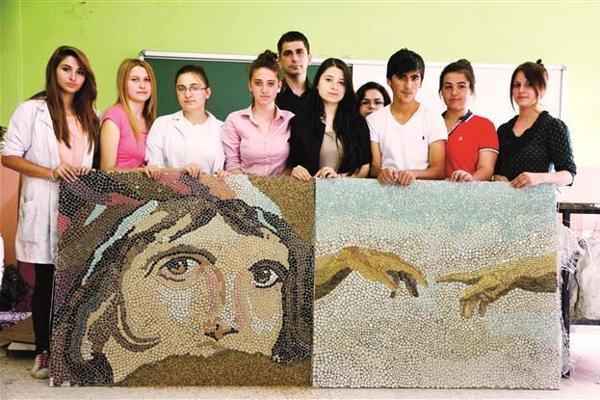Students of Bartın make famous Zeugma artifact from ceramics
BARTIN - Anatolia News Agency


The waste ceramics have been glued with special glue to create the details of the famous artifact ‘Gypsy Girl’ of Zeugma. Earlier the students also created details of Michelangelo’s famous Sistine Chapel wall frescoes with ceramics. AA photo
The ancient city of Zeugma’s prominent artifact mosaic “Gypsy Girl,” became a ceramic artwork in Bartın. The sculpture was made with ceramics students gathered and a total of 5,000 pieces of ceramic was used. The sculpture has also became a mosaic sculpture just like its original. Students used waste to create the sculpture. The ceramic waste from their bathrooms and kitchens was collected at the atelier. The students first divided the ceramics into small pieces and then gathered them according to their colors to create the “Gypsy Girl” of Zeugma. The students also work on other famous artworks.The ceramics have been glued with exclusive glue. Earlier the students also created Michelangelo’s Sistine Chapel’s wall frescoes with ceramics.
The “Gypsy Girl,” which is one of the most important artifacts of Zeugma, is one square meter.
Scholars have suggested that the “Gypsy Girl,” named for the wild look in her eyes, might be Gaea, the goddess of the Earth. Hesiod, an 8th century B.C. Greek poet, whose account of how the gods came into existence is considered the classic version, wrote that in the beginning there was Chaos, which in Greek means “yawning.” Into that yawning, or void, came Gaea (Earth), Tartarus (the lowest region of the underworld), Eros (Love), Erebus (the personification of Tartarus) and Night. With Uranus, god of the sky, Gaea gave birth to the Titans, 12 gods that included Oceanus and Tethys.
Gathering ceramics
The visual arts teacher of the students Özer Başpınar said the students’ works were completed within one year.
Both the “Gypsy Girl” of Zeugma and the frescoes of the Sistine Chapel were made using 10,000 pieces of ceramics. The details of both artifacts are made with the ceramics, added Başpınar.
The students will display those artifacts in their schools, said Başpınar.
They tried to make the works close to original ones, Başpınar said. “This is a long and hard task. In order to make the artifacts look better we kept the dimensions large.”
“Making the pieces big and large makes the task harder,” he added.
The mosaic paintings also reflect how people can evaluate the waste in their homes. The hardest part was separating the ceramics according to their colors, he added. The tones of colors and gathering pieces are very hard, he said.
The aim is to reflect the cultural heritage behind the works. The ancient city of Zeugma was originally founded as a Greek settlement by Seleucus I Nicator, one of the generals of Alexander the Great, in 300 B.C. King Seleucus almost certainly named the city Seleucia after himself; whether this city is, or can be, the city known as Seleucia on the Euphrates or Seleucia at the Zeugma is disputed. The population in the city at its peak was approximately 80,000. The Sistine Chapel’s wall frescoes were made by the great painter Michelangelo.
